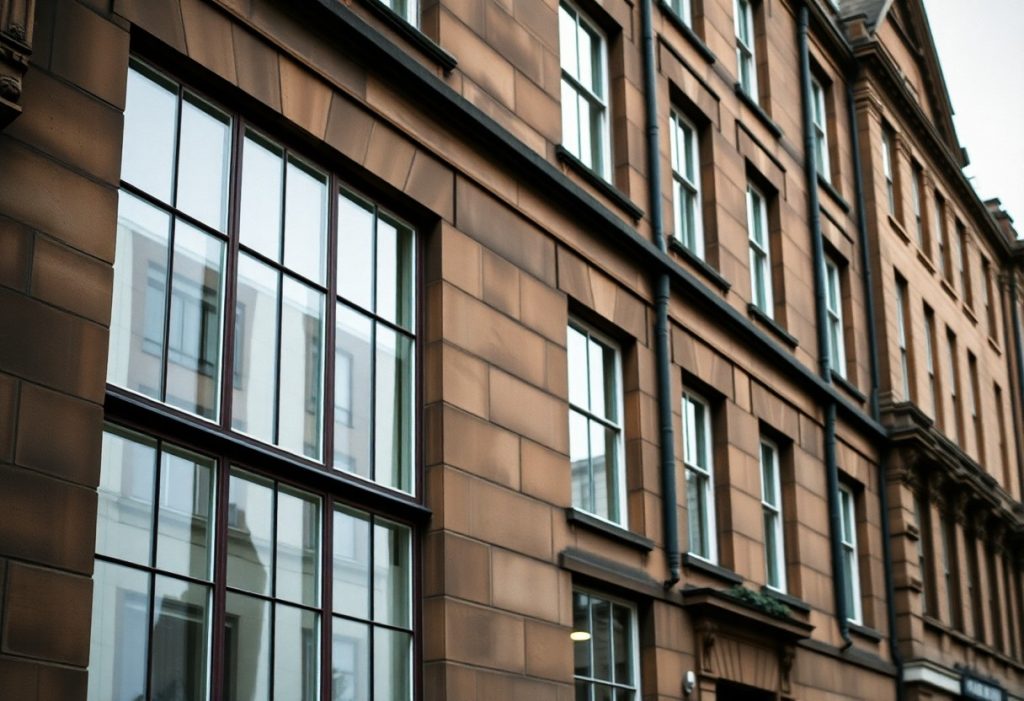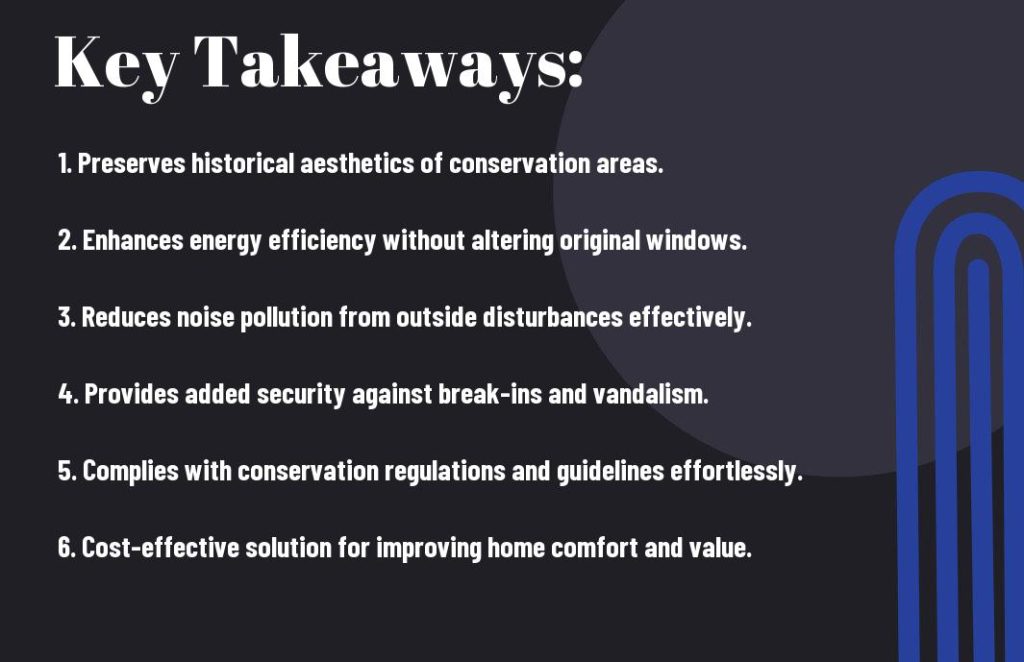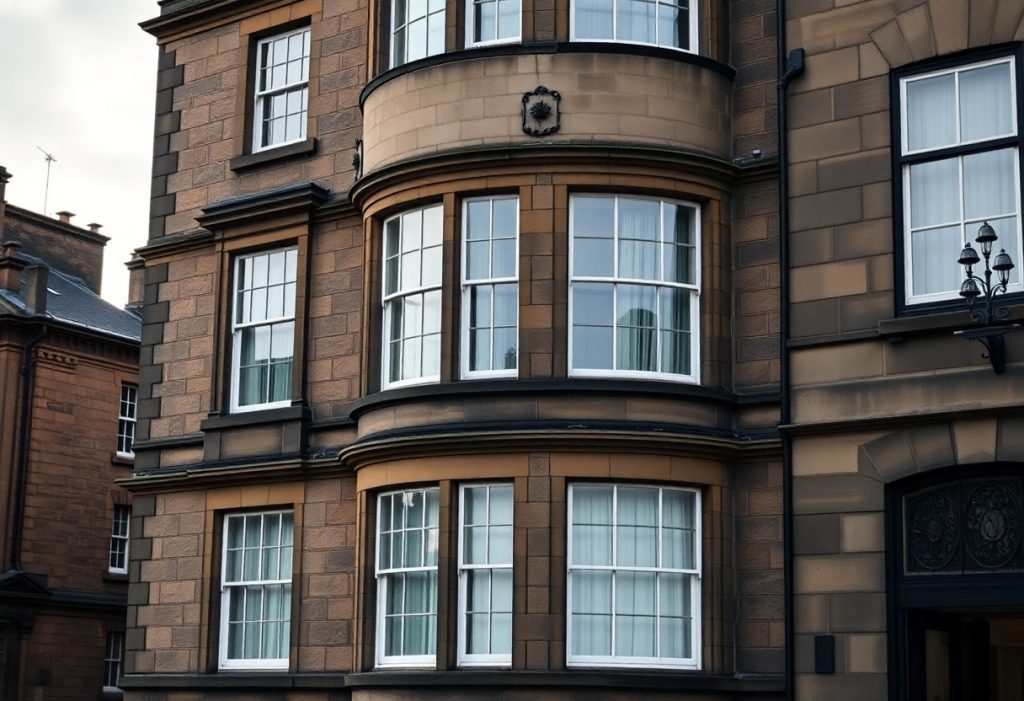Secondary Glazing is a perfect alternative in a conservation area in Glasgow
Glazing solutions like secondary glazing offer you an excellent alternative to traditional methods, particularly in conservation areas in Glasgow. This innovative approach allows you to enhance your home’s energy efficiency while maintaining the original aesthetic, helping to preserve the historical character of your property. By installing secondary glazing, you can significantly reduce heat loss and external noise, ensuring a more comfortable living space while adhering to local regulations. Explore secondary glazing to enjoy the benefits of modern performance without compromising your home’s heritage.

Key Takeaways:
- Preservation of Aesthetics: Secondary glazing provides an effective solution without altering the character of historic buildings, making it ideal for conservation areas in Glasgow.
- Enhanced Insulation: This option significantly improves thermal comfort by reducing heat loss, helping to maintain a stable indoor climate.
- Noise Reduction: Secondary glazing acts as a sound barrier, contributing to a quieter home environment by minimizing external noise pollution.
- Cost-Effective Solution: It offers a more affordable alternative to full window replacements, extending the lifespan of original windows while enhancing energy efficiency.
- Easy Installation: Secondary glazing can be installed with minimal disruption to your home, making it a practical choice for homeowners concerned about preserving their property’s integrity.
What is Secondary Glazing?
While exploring options for enhancing your home’s energy efficiency, secondary glazing offers a fantastic solution, especially in conservation areas like Glasgow. This technique involves adding a second pane of glass to existing windows, providing an additional layer of insulation and soundproofing without compromising the aesthetic appeal of your property. It allows you to maintain the character of traditional architecture while enjoying modern benefits.
Definition and Purpose
Around Glasgow, secondary glazing serves as a practical answer to the challenges of older buildings, offering enhanced thermal performance and noise reduction. Its primary purpose is to bolster your existing windows, making them more energy-efficient and comfortable while safeguarding the architectural integrity of your home.
Comparison with Double Glazing
At a glance, secondary glazing and double glazing may seem similar, but they have distinct differences that meet varied needs. Here’s a quick comparison:
Comparison Table
| Feature | Secondary Glazing |
|---|---|
| Installation | Easily retrofitted to existing windows |
| Cost | Generally lower than full replacements |
| Aesthetic Impact | Preserves original window style |
| Energy Efficiency | Improves thermal performance without altering exterior |
With secondary glazing, you get an affordable option that adds value to your home through improved insulation while keeping your property’s historical character intact. This is particularly advantageous in conservation areas, where regulations often limit the types of alterations you can make. You can achieve significant energy savings, reducing heating costs and contributing to a more sustainable living environment without sacrificing the beauty of your home.


Benefits of Secondary Glazing in Conservation Areas
Even if you live in a conservation area in Glasgow, you can enhance your home without compromising its historical charm. Secondary glazing serves as an effective solution to complement existing windows while providing additional insulation and noise reduction, making it easier for you to enjoy the beauty of your surroundings.
Preserving Aesthetic Integrity
Conservation areas require strict adherence to aesthetic guidelines, but secondary glazing allows you to maintain your home’s traditional character. You can have the benefits of modern insulation technology without altering the original windows, ensuring your property remains in harmony with its historical environment.
Enhancing Energy Efficiency
Glazing your windows with secondary options can significantly boost your home’s energy efficiency. Studies show that replacing single-glazed units can save you hundreds of pounds a year on heating costs. This added layer of glass acts as a thermal barrier, keeping the cold out during winter and maintaining a comfortable indoor climate year-round. By minimizing heat loss, secondary glazing not only enhances your comfort but can also increase the overall value of your property in the long term.
Legal Considerations for Conservation Areas
To ensure compliance when upgrading your windows in a conservation area, it’s vital to understand the legal considerations specific to your location. Conservation areas in Glasgow are landscapes of historic and architectural significance, and any changes must preserve their character. Secondary glazing offers a *non-intrusive* option that enhances energy efficiency without altering the exterior appearance of your home, making it a suitable choice for these protected settings.
Planning Permission Requirements
Along with understanding the regulations, you may need to seek planning permission for certain renovations. Although secondary glazing usually does not require planning permission, it is advisable to check with your local council. This process ensures that your installations align with conservation area standards and maintain the integrity of your property.
Regulations and Best Practices
Beside obtaining necessary permissions, it’s vital to follow *best practices* when installing secondary glazing. This includes using high-quality materials and ensuring that installations are reversible. By adhering to regulations, you not only protect your property but also contribute positively to the character of your neighborhood.
With *compliance* and *quality* at the forefront, your approach to secondary glazing should align with established guidelines. Choosing glazing that minimizes visual impact and maximizes *thermal efficiency* will benefit both your home and the surrounding area. Highlighting the historical context of your property, secondary glazing can effectively serve as a barrier against temperature fluctuations, reduce external noise, and promote energy savings, allowing you to enjoy a comfortable living space while maintaining your home’s heritage.
Installation Process of Secondary Glazing
Many homeowners in conservation areas can enhance their property’s energy efficiency and comfort through the installation of secondary glazing. This process involves adding an additional layer of glazing to your existing windows, which can significantly reduce heat loss and outside noise while preserving the character of your home. Working with experienced professionals ensures that the installation meets local regulations and blends seamlessly with the architectural style of your property, providing a solution that is both effective and aesthetically pleasing.
Professional Installation vs. DIY
Between hiring a professional or attempting a DIY project, you’ll find that professional installation often yields superior results. Experts not only possess the necessary skills to ensure a perfect fit but also understand the specific requirements of conservation areas in Glasgow. This knowledge is important in navigating building regulations and optimizing your installation for both performance and preservation.
Essential Tools and Materials
After deciding to install secondary glazing, you’ll need the right tools and materials to ensure a successful project. Essential items include measuring tapes, levelers, adhesive, secondary glazing panels, and sealant. Having these tools on hand will help you achieve a snug fit that enhances energy efficiency and reduces noise.
With the proper tools and materials, your secondary glazing installation can become a rewarding project. The use of pre-cut secondary glazing panels can minimize waste and ensure a customizable fit for your windows, enhancing their functionality without detracting from their character. Additionally, investing in high-quality adhesive and sealants will help create an airtight seal, further improving energy efficiency and comfort in your conservation area home.
Maintenance of Secondary Glazing
Your secondary glazing will provide lasting benefits in your Glasgow conservation area when well-maintained. Regular upkeep can enhance your windows’ performance and aesthetics while ensuring they comply with local regulations. A simple routine of cleaning and inspecting the frames, seals, and glass will help preserve their condition and functionality.
Routine Inspection Tips
To keep your secondary glazing in top shape, consider these maintenance tips:
- Inspect seals for wear and tear
- Clean frames and glass regularly
- Check for drafts and address them promptly
- Ensure ease of opening and closing mechanisms
Any neglect in these areas could lead to reduced efficiency and potential damage.
Common Issues and Solutions
Against common misconceptions, secondary glazing is generally low-maintenance, but issues can arise. You may encounter drafts if seals are damaged, leading to reduced energy efficiency. Another potential issue is condensation between the panes, which can be remedied by ensuring proper ventilation. Additionally, misalignment can cause operational difficulties; you can adjust these by re-cornering the frame. It’s crucial to address these concerns timely to retain the energy-efficient and protective qualities of your windows, enhancing your home’s value while preserving its character.
Case Studies: Successful Secondary Glazing Projects in Glasgow
Not only does secondary glazing enhance energy efficiency in conservation areas, but your windows can also gain aesthetic appeal while preserving their historical integrity. Here are some successful projects in Glasgow that demonstrate the effectiveness of this solution:
- Heritage Home in Glasgow Southside: Achieved a 40% reduction in heat loss with secondary glazing.
- Protected Listed Building: Improved sound insulation by 30%, allowing occupants to enjoy peace in a bustling neighborhood.
- Victorian Tenement: Increased property value by implementing bespoke secondary glazing that harmonizes with the building’s character.
- Edwardian Home in Govanhill: Successfully minimized drafts, resulting in a 15% decrease in heating costs during winter.
Each of these projects highlights how secondary glazing not only meets the practical needs of homeowners in conservation areas but also respects and enhances the unique architecture of Glasgow, ensuring you don’t compromise on style while improving your home’s energy performance.
Final Words
On the whole, secondary glazing is a perfect alternative for your home in a conservation area in Glasgow. It effectively improves thermal insulation, reduces noise, and enhances the security of your windows without compromising the character of your property. By choosing secondary glazing, you can preserve the original features of your home while enjoying modern energy efficiency benefits. This solution allows you to maintain your property’s aesthetic appeal while contributing to a more comfortable living environment, making it an excellent choice for homeowners who value both tradition and practicality.
FAQ
Q: What is secondary glazing?
A: Secondary glazing involves adding a second layer of glazing to your existing windows. This can be done with a range of materials, typically glass or acrylic, and is designed to enhance insulation and soundproofing without altering the exterior look of the building.
Q: Why should I consider secondary glazing in a conservation area in Glasgow?
A: In conservation areas, preserving the architectural character of buildings is necessary. Secondary glazing provides energy efficiency and noise reduction while allowing homeowners to maintain the original windows’ aesthetics, ensuring compliance with local regulations regarding building alterations.
Q: What are the energy efficiency benefits of secondary glazing?
A: Secondary glazing significantly improves the thermal performance of existing windows. It reduces heat loss, which can lead to lower energy bills and increased comfort within the home during colder months. This is especially beneficial in Glasgow’s variable climate.
Q: Can secondary glazing reduce noise pollution?
A: Yes, one of the primary advantages of secondary glazing is its ability to minimize external noise. This is particularly valuable in urban areas of Glasgow, where street noise can disrupt daily life. Secondary glazing acts as an additional barrier, reducing sounds from traffic and other sources.
Q: Will secondary glazing affect ventilation?
A: Secondary glazing can be designed to allow for ventilation through various means, such as trickle vents or opening sections. This ensures that while you benefit from improved insulation and soundproofing, your home remains well-ventilated and comfortable.
Q: How does secondary glazing impact the property’s value?
A: Upgrading to secondary glazing can enhance the overall value of your property. Not only does it improve the energy efficiency of your home, but it also helps preserve the historical and aesthetic integrity of buildings in conservation areas, making them more attractive to potential buyers.
Q: Is secondary glazing a cost-effective solution?
A: Yes, secondary glazing is often more cost-effective than replacing original windows. It typically requires less investment while providing substantial benefits in terms of insulation, noise reduction, and maintaining the historical accuracy of properties within conservation areas.



